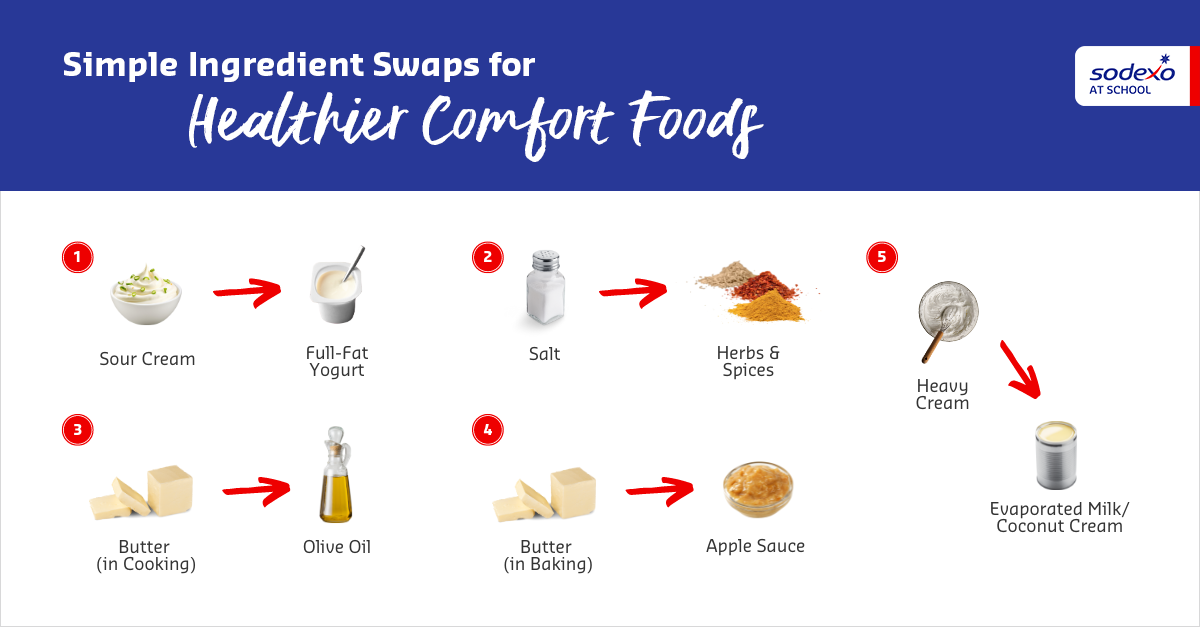Making changes to our children’s diets can be a daunting task — and when you’re motivated to instill healthier habits for your students, navigating through the sea of nutrition advice can be overwhelming. But fear not! The key to success lies in starting small. Instead of attempting a complete overhaul of your eating habits, start with just a few simple swaps or adjustments. By gradually incorporating healthier choices into your favorite recipes, you can still enjoy comfort food while improving its nutritional profile.
When it comes to basic ingredient swaps for better health, simple changes can make a big difference. Opting for whole wheat bread over white bread provides more fiber and nutrients, keeping you fuller for longer and stabilizing blood sugar levels. Similarly, choosing whole grain pasta instead of white pasta boosts fiber intake and promotes digestive health. Trading white rice for brown rice not only adds nutty flavor but also increases the fiber content and supports heart health. These easy swaps are delicious ways to enhance the nutritional value of your meals without sacrificing taste.
While opting for whole grains is a fairly widespread practice, here are some lesser-known easy and affordable recipe swaps that will help you create healthier versions of your beloved comfort foods:
1. Sour Cream → Full-Fat Yogurt (Traditional or Greek): Swapping full-fat yogurt for sour cream is a seamless transition that won't compromise taste or texture. Not only does yogurt provide a creamy consistency, but it also adds a protein and active cultures boost to your dish. Consider the type of yogurt to use based on your recipe. Greek yogurt offers a texture similar to sour cream, while traditional yogurt imparts a taste reminiscent of the original ingredient.
2. Salt → Herbs and Spices: Reduce your reliance on salt by incorporating herbs and spices into your cooking. Not only do they enhance flavor, but they also provide a plethora of antioxidants and micronutrients. To maximize their taste potential, toast your spices with dry heat or fry them in olive oil. The fat-soluble compounds in spices linger on your taste buds longer when consumed with fat, intensifying the flavor experience.
3. Butter (in Cooking) → Olive Oil: While butter adds richness to dishes, it also contains higher levels of saturated fats compared to oils. Opt for olive oil as a healthier alternative, considering factors such as flavor profile, smoke point and unsaturated fat content. Choose the appropriate oil based on your cooking method to achieve optimal results.
4. Butter (in Baking) → Applesauce: Replace butter with unsweetened applesauce in baking recipes for a lighter, healthier option. Applesauce provides the necessary moisture to bind dry ingredients together while adding soluble fiber to your baked goods. With a simple 1:1 ratio swap, you can enjoy moist, flavorful treats without sacrificing taste or texture.
5. Heavy Cream → Evaporated Milk or Coconut Cream: Cut down on the fat and calorie content of your dishes by substituting heavy cream with evaporated milk or coconut cream. Evaporated milk offers a similar consistency to heavy cream but with half the calories and fat, while coconut cream adds a delightful tropical twist to your recipes while providing a lighter alternative to heavy cream.
By incorporating these simple ingredient swaps into your cooking repertoire, your students can enjoy their favorite comfort foods — and you can enjoy knowing they are getting a balanced, nutritious diet. Remember, small changes can lead to big results when it comes to improving your diet. Don't be afraid to get creative in the kitchen and experiment with healthier alternatives. Your kids’ taste buds and bodies will thank you!


